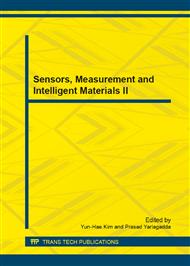[1]
S. Haykin, Zhe Chen. The cocktail party problem: Neural Computation. Vol. 17(9), p.1875–1902, (2005).
DOI: 10.1162/0899766054322964
Google Scholar
[2]
H. Le Borgne, A, Guérin-Dugué, A. Antoniadis. Representation of images for classification with independent features: Pattern Recognition Letters. Vol. 25(2), p.141–154, (2004).
DOI: 10.1016/j.patrec.2003.09.011
Google Scholar
[3]
W. Wang , J. A. Chambers, S. Sanei. A novel hybrid approach to the permutation problem of frequency domain bind source separation: ICA 2004 LNCS 3195, p.532–539, (2004).
DOI: 10.1007/978-3-540-30110-3_68
Google Scholar
[4]
Yau, R. Macroeconomic forecasting with independent component analysis: Econometric Society 2004 Far Eastern Meetings, Econometric Society. Vol. (741), (2004).
Google Scholar
[5]
A. Hyvärinen , E. Oja, A fast fixed-point algorithm for independent component analysis: Neural computation, Vol. 9(7), pp.1483-1492, (1997).
DOI: 10.1162/neco.1997.9.7.1483
Google Scholar
[6]
M. Zibulevsky, P. Kisilev, Y. Y. Zeevi& B. A. Pearlmutter. Blind source separation via multinode sparse representation. In Advances in neural information processing systems, pp.1049-1056, (2001).
DOI: 10.1109/icip.2001.958086
Google Scholar
[7]
O. Yilmaz , S. Rickard. Blind separation of speech mixtures via time-frequency masking: IEEE Trans. Sig. Proc., Vol. 52(7), p.1830–1847, (2004).
DOI: 10.1109/tsp.2004.828896
Google Scholar
[8]
M. I. Mandel, S. Bressler, B. Shinn-Cunningham & D. P. W. Ellis. Evaluating source separation algorithms with reverberant speech: IEEE Transactions on audio speech and language processing, Vol. 18(7), pp.1872-1883, (2010).
DOI: 10.1109/tasl.2010.2052252
Google Scholar
[9]
S. K. Basha, P. C. Pandey. Real time enhancement of electrolaryngeal speech by spectral subtraction: Proc. 18th national conference on communications, pp.516-520, (2012).
DOI: 10.1109/ncc.2012.6176807
Google Scholar
[10]
S. M. Hariharan, S. Kamal & S. Pillai. Reduction of self-noise effects in onboard acoustic receivers of vessels using spectral subtraction: Acoustics 2012 Nantes. pp.3793-3798, (2012).
Google Scholar
[11]
D. Sodoyer, B. Rivet, L. Schwartz, J. L. Schwartz & C. Jutten. An analysis of visual speech information applied to voice activity detection. IEEE International Conference on Acoustics, Speech and Signal Processing. Vol(1), pp.1-1, (2006).
DOI: 10.1109/icassp.2006.1660092
Google Scholar


